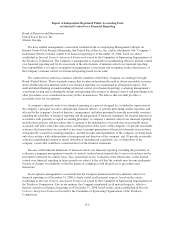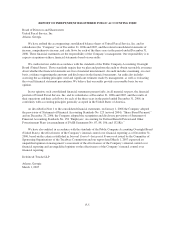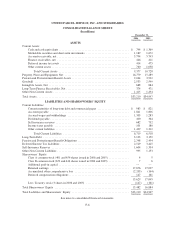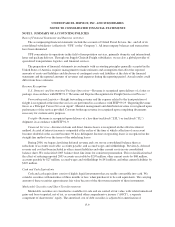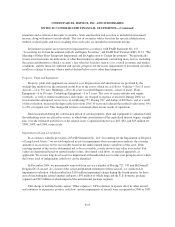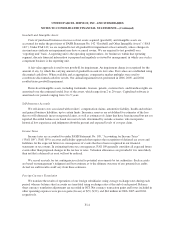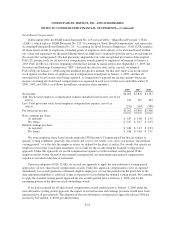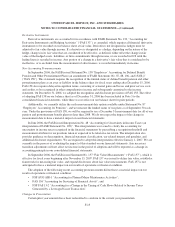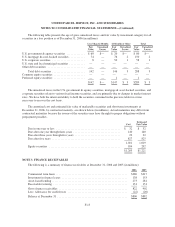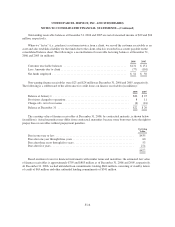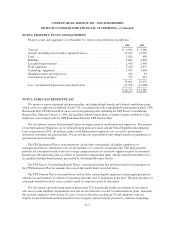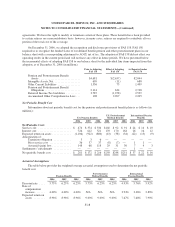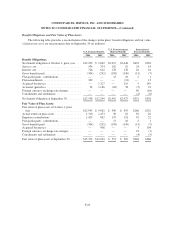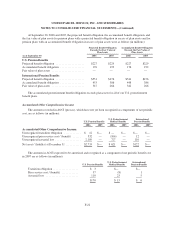UPS 2006 Annual Report Download - page 73
Download and view the complete annual report
Please find page 73 of the 2006 UPS annual report below. You can navigate through the pages in the report by either clicking on the pages listed below, or by using the keyword search tool below to find specific information within the annual report.UNITED PARCEL SERVICE, INC. AND SUBSIDIARIES
NOTES TO CONSOLIDATED FINANCIAL STATEMENTS—(Continued)
Derivative Instruments
Derivative instruments are accounted for in accordance with FASB Statement No. 133, “Accounting for
Derivative Instruments and Hedging Activities” (“FAS 133”), as amended, which requires all financial derivative
instruments to be recorded on our balance sheet at fair value. Derivatives not designated as hedges must be
adjusted to fair value through income. If a derivative is designated as a hedge, depending on the nature of the
hedge, changes in its fair value that are considered to be effective, as defined, either offset the change in fair
value of the hedged assets, liabilities, or firm commitments through income, or are recorded in OCI until the
hedged item is recorded in income. Any portion of a change in a derivative’s fair value that is considered to be
ineffective, or is excluded from the measurement of effectiveness, is recorded immediately in income.
New Accounting Pronouncements
In September 2006, the FASB issued Statement No. 158 “Employers’ Accounting for Defined Benefit
Pension and Other Postretirement Plans (an amendment of FASB Statements No. 87, 88, 106, and 132(R))”
(“FAS 158”). This statement requires the recognition of the funded status of defined benefit pension and other
postretirement plans as an asset or liability in the balance sheet for fiscal years ending after December 15, 2006.
FAS 158 also requires delayed recognition terms, consisting of actuarial gains and losses and prior service costs
and credits, to be recognized in other comprehensive income and subsequently amortized to the income
statement. On December 31, 2006, we adopted the recognition and disclosure provisions of FAS 158. The effect
of adopting FAS 158 on our balance sheet as of December 31, 2006 has been included in Note 5 to the
consolidated financial statements, while there was no effect on our balance sheet for prior periods.
Additionally, we currently utilize the early measurement date option available under Statement No. 87
“Employers’ Accounting for Pensions”, and we measure the funded status of our plans as of September 30 each
year. Under the provisions of FAS 158, we will be required to use a December 31 measurement date for all of our
pension and postretirement benefit plans no later than 2008. We do not expect the impact of the change in
measurement date to have a material impact on our financial statements.
In June 2006, the FASB issued Interpretation No. 48 “Accounting for Uncertainty in Income Taxes (an
interpretation of FASB Statement No. 109)”. This interpretation was issued to clarify the accounting for
uncertainty in income taxes recognized in the financial statements by prescribing a recognition threshold and
measurement attribute for tax positions taken or expected to be taken in a tax return. The interpretation also
provides guidance on derecognition, financial statement classification, tax-related interest and penalties, and
additional disclosure requirements. We are required to adopt this interpretation effective January 1, 2007. We are
currently in the process of evaluating the impact of this standard on our financial statements. Any necessary
transition adjustments will not affect net income in the period of adoption and will be reported as a change in
accounting principle in our consolidated financial statements.
In September 2006, the FASB issued Statement No. 157 “Fair Value Measurements” (“FAS 157”), which is
effective for fiscal years beginning after November 15, 2007. FAS 157 was issued to define fair value, establish a
framework for measuring fair value, and expand disclosures about fair value measurements. FAS 157 is not
anticipated to have a material impact on our results of operations or financial condition.
The adoption of the following recent accounting pronouncements did not have a material impact on our
results of operations or financial condition:
• FSP AUG AIR-1 “Accounting for Planned Major Maintenance Activities”;
• FAS 156 “Accounting for Servicing of Financial Assets”; and
• FSP FAS 13-2 “Accounting for a Change in the Timing of Cash Flows Related to Income Taxes
Generated by a Leveraged Lease Transaction”.
Changes in Presentation
Certain prior year amounts have been reclassified to conform to the current year presentation.
F-13


